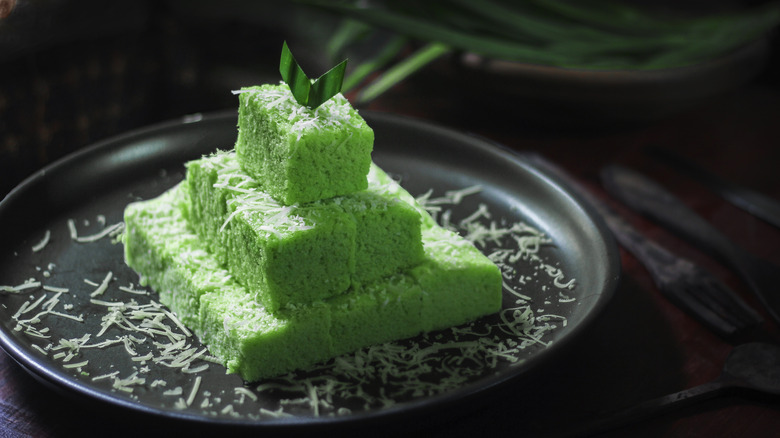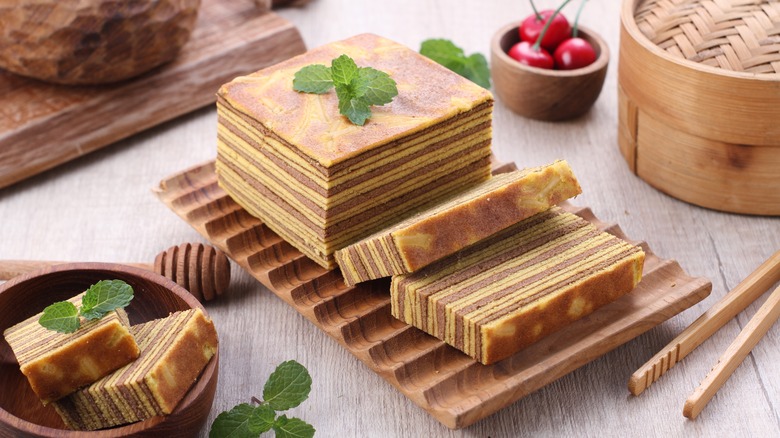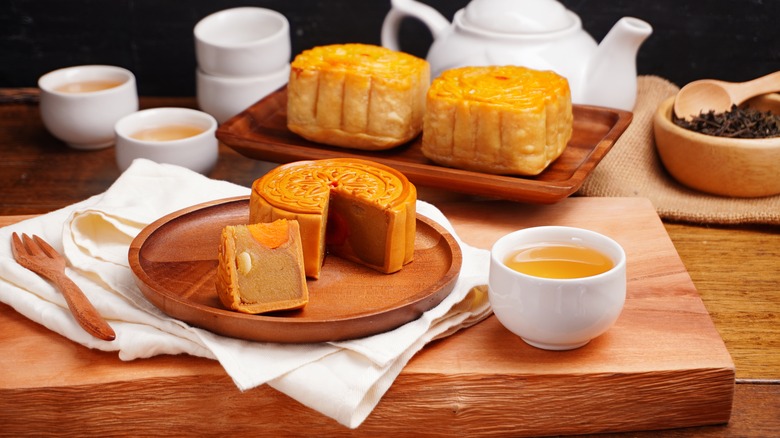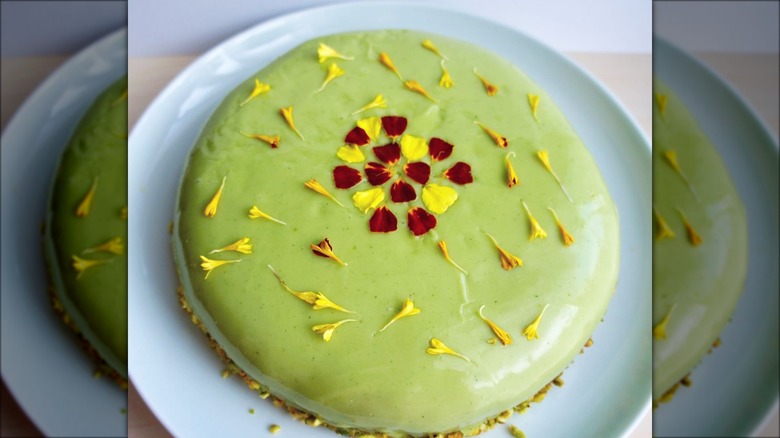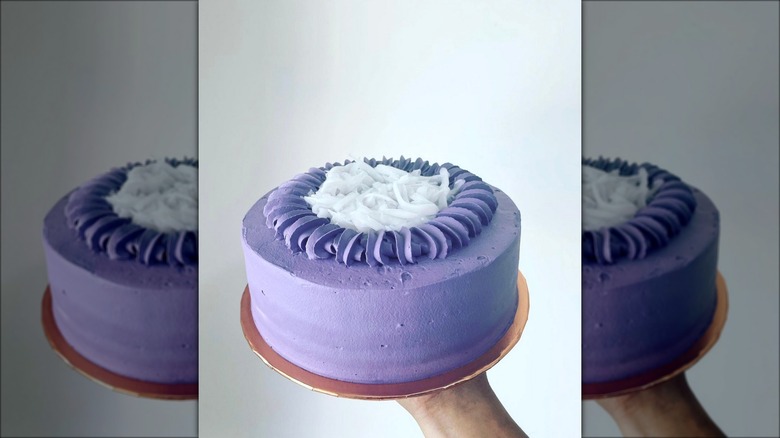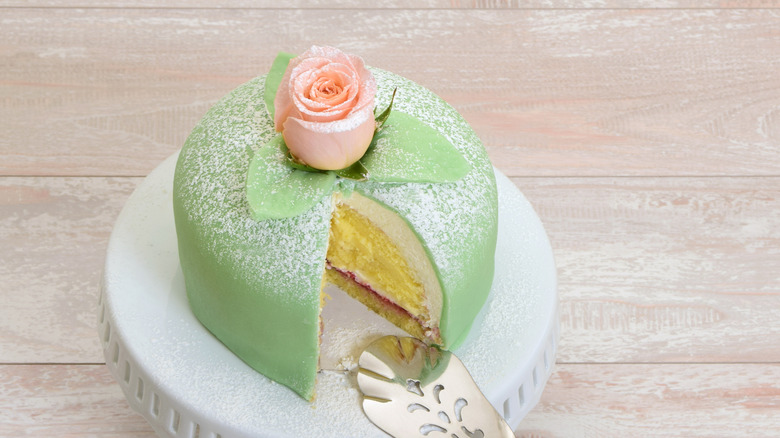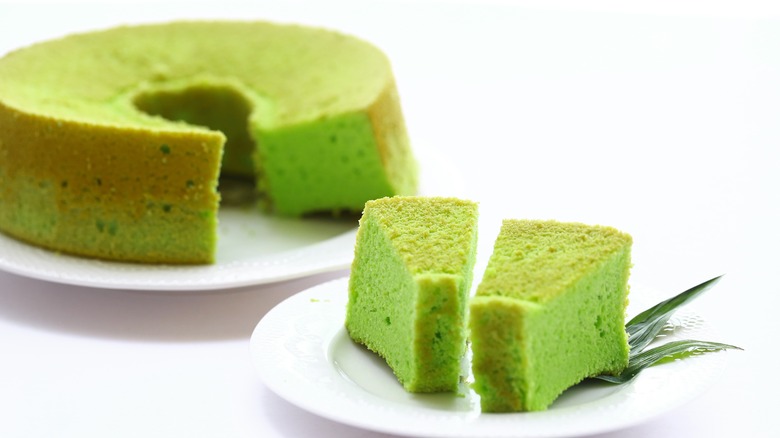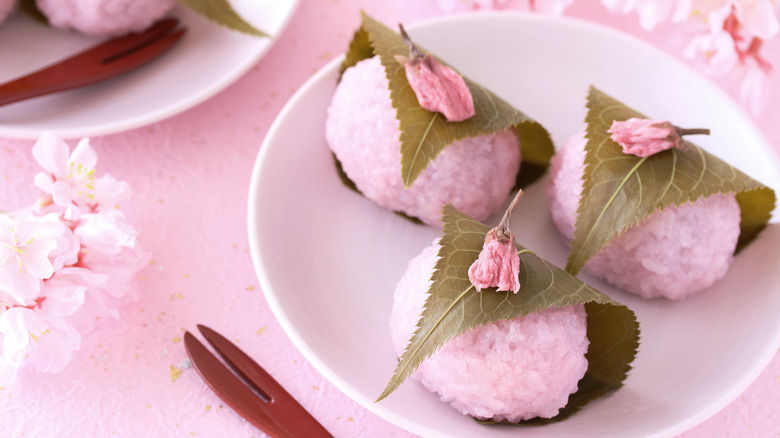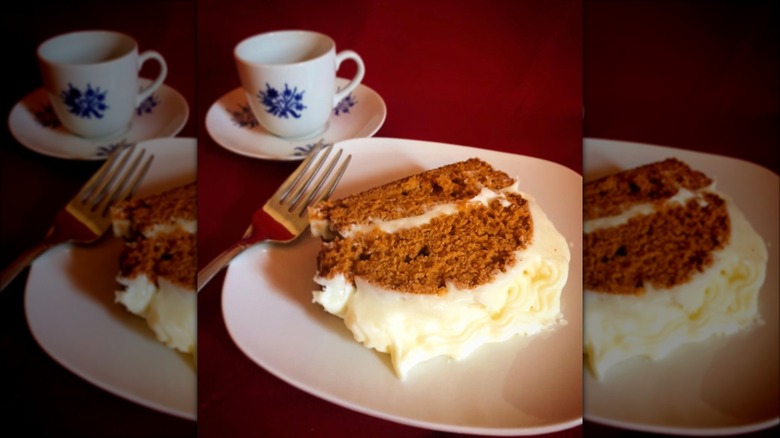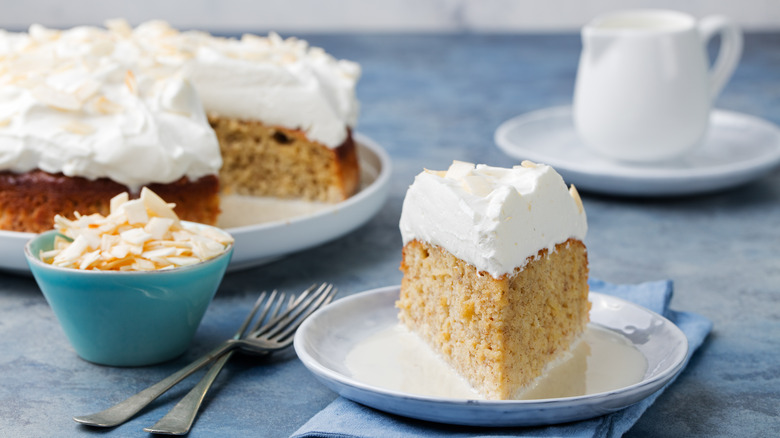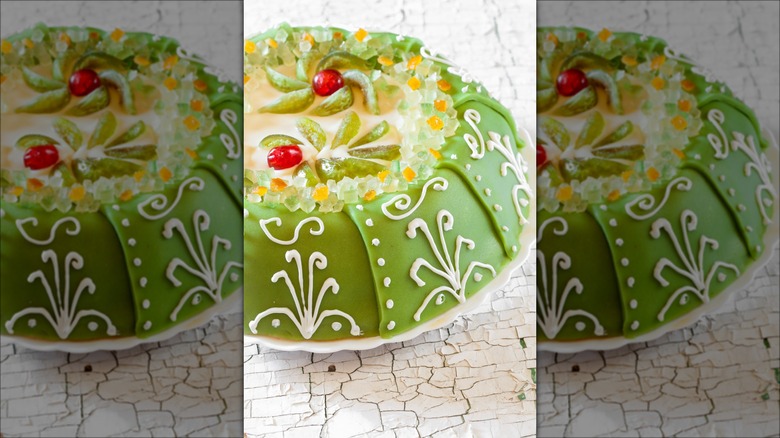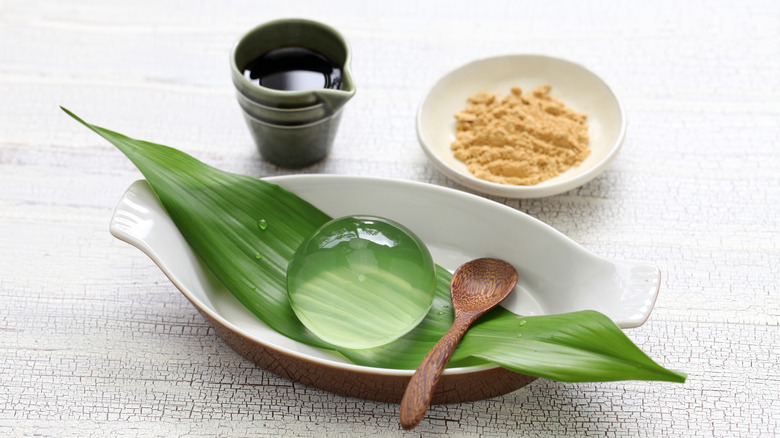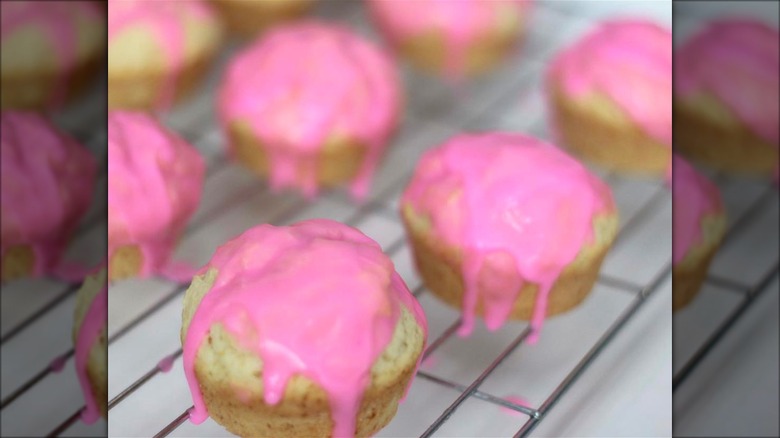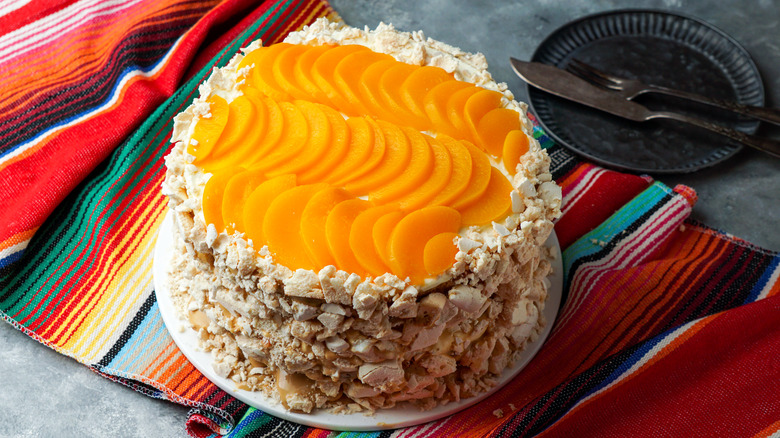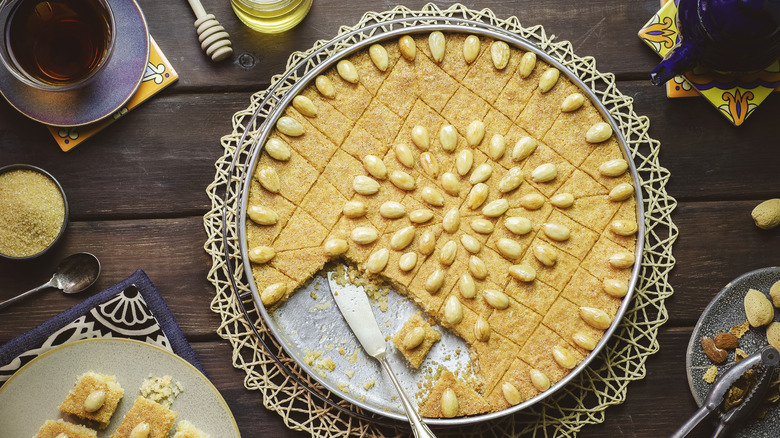The Most Unique Cakes From Around The World
As of 2019, the global cake market was valued at an estimated $43 billion (per Grand View Research). Around the world, cakes are a universal signifier of a special occasion. Whether it's a wedding, birthday party, or going away bash, this broad category of dessert is inextricably linked to some of the most foundational moments in life. From elaborate, multi-tiered wedding cakes to the less-than-elegant ones you bake from scratch for family gatherings, this famous saying (sometimes attributed to Julia Child) holds true: "A party without cake is just a meeting."
There are the familiar cake flavors–-red velvet, carrot, angel food, and chocolate, to name a few–-but cuisines across the globe have variations all their own. Some of the most unique cakes use ingredients that are specific to particular regions, while others use everyday ingredients, but are deeply rooted in the culture of their place of origin. We've rounded up some of the most distinctive cakes from around the world to inspire your next baking adventure or vacation destination.
Indonesia - Lapis Legit
Containing up to 30 individually baked layers, apis legit is a labor-intensive cake with an extensive history. In Indonesia, it's a remnant of Dutch colonialism stretching back to the 16th century that has been transformed into a distinctly Indonesian dessert. The cake began in colonial kitchens, where the Dutch attempted to recreate the German recipe for baumkuchen, a many-layered cake baked on a spit. Over time, however, Indonesians added nutmeg, cloves, cardamom, and cinnamon to make it their own, and unlike the Germans, cooked it in a cake tin.
Aside from its eye-catching lamination and fragrant spices, lapis legit is beloved for its decadence. Traditional recipes use up to 40 egg yolks and close to five sticks of butter, making it the kind of treat you can only have in moderation and for special occasions. It is such a prized and complicated cake to master that one company in the U.S. sells each cake for $88. If you're feeling brave and have time on your hands, there are worse ways to spend an afternoon than making your own version of this "thousand-layer" marvel.
China - Mooncake
The Mid-Autumn Festival takes place during the eighth lunar month of the year. It usually occurs in September or October and coincides with the full moon closest to the autumnal equinox. In China, the holiday is not complete without mooncakes, called yuè bĭng (月餅), which are handed out to loved ones and colleagues to signify family and harmony. In 2021, sales of the pastry topped $3 billion (per Statista), and it is so popular that companies including Starbucks and Häagen-Dazs release their own versions every year.
Traditional mooncake recipes call for a delicate pastry filled with sweet bean paste, lotus seed paste, or date paste, though there are plenty of modern variations. Starbucks, for example, offers sea salt and espresso-flavored mooncakes and one with lime and cheese. Snow skin mooncakes are a no-bake version of the traditional treat with a white exterior made of rice flour. One of the most common fillings has a salted egg yolk in the center to symbolize the moon.
France - Le Gâteau Vert
The name "Claude Monet" probably conjures images of waterlilies, art galleries, and French sophistication, but not cake. However, the famed artist was known to his friends and family for the craft and aesthetic eye he brought to his sprawling garden in northern France, and with his appreciation for seasonal gardening came a love of cooking. He even produced his own cookbook. Of all his favorite dishes, including the banana ice cream that he ate at Christmas every year, Le Gâteau Vert is rumored to have been his most beloved cake.
French for "green cake," Le Gâteau Vert gets its distinctive color from an unlikely ingredient: spinach. A classic génoise sponge with kirsch liqueur and pistachios forms the base of the recipe with a filling made of pistachios, kirsch, butter, sugar, eggs, flour, and milk. The cake is then covered with butter frosting colored with spinach juice and decorated with rose petals and pistachio pieces. Unsurprisingly, given the intricacy and skill of Monet's paintings, Le Gâteau Vert is neither quick nor easy to craft, but it makes for a breathtaking spring dessert, especially for an outdoor tea party bathed in sunlight.
Philippines - Ube Macapuno Cake
Ube is a type of yam that grows in the Philippines. Its deep purple color makes it an eye-catching ingredient, but it also has a flavor all its own. Nutty, earthy, faintly sweet, and with a hint of vanilla, it's most often found in the popular Filipino dessert halo-halo, a parfait-adjacent treat that layers ingredients such as ube ice cream, condensed milk, fresh fruit, coconut, corn kernels, and puffed rice.
Ube macapuno cake is another popular use of the violet-hued tuber. Aside from its striking color and earthy, vanilla flavor (usually derived from ube extract rather than the plant itself), the cake is typically a simple chiffon or sponge layered with buttercream. Macapuno is the ingredient with which many cooks outside of Southeast Asia will be even less familiar than ube. Although technically a coconut, its flesh is sweet and gelatinous due to a genetic mutation that food scientists cultivate through embryo culture. Ube macapuno cake recipes often call for the specialty coconut to be sandwiched between the layers and piled on top to maximize its unique flavor and appearance.
Sweden - Prinsesstårta
One of Sweden's most famous cakes has a royal history. The Prinsesstårta first appeared in a 1948 cookbook written by famed home economics teacher Jenny Åkerström. The book's title, "Princesses Cookbook: Home Cooking and Holiday Food," alluded to Åkerström's most famous pupils, the three nieces of King Gustaf V. Åkerström. She taught the princesses a range of domestic skills such as child rearing and cooking, but also involved them in recipe creation. The first edition of her cookbook was so popular that she produced eighteen editions, adding recipes along the way.
At some point, the "Green Cake" that appeared in the 1948 edition morphed into the Prinsesstårta. The name change has been explained in a variety of ways. One theory goes that it was the princesses' favorite recipe, while another argues that the recipe is an amalgamation of three cakes that Åkerström made for each princess. Whatever its origins, the Prinsesstårta is a Swedish favorite. Featuring a light sponge cake layered with vanilla custard, strawberry jam, and cream, it's covered in a light-green sheath of marzipan and adorned with a pink fondant rose and powdered sugar. In flavor and appearance, it is most certainly a cake fit for royalty.
Singapore - Pandan Cake
In Southeast Asia, fragrant pandan leaves are used in just about everything. Equally transformative in desserts and hearty, savory dishes, it has been compared to vanilla but is used more broadly. Curries, rice, and ice cream are just a few of the foods that often contain the ingredient, and the leaves are often used to wrap meat for barbecuing. The flavor is frequently described as floral, lightly sweet, aromatic, and with a hint of grassiness. Pandan is used for its color as much as its taste. In places like Singapore and Vietnam, foods such as cendol, a dessert made with strings of pandan-dyed rice jelly, and kaya, a coconut, pandan custard, revolve around its vibrant hue.
Baking is another popular use for the brightly-colored leaves. Pandan chiffon cake uses coconut milk (a flavor often paired with the plant) to add another layer of intrigue to the recipe. Pandan extract is used to heighten the soft flavor, while a food processor is used to turn the leaves into a paste that is strained and turned into dye. The color of the cake varies depending on how much green juice you use, but it is often no more than a faint tinge, enough to grab your attention but not enough to look artificial.
Japan - Sakura Mochi
In Japan, mochi are one of the most popular treats. Made from glutinous rice called mochigome, the cakes are small and round and come in a wide variety of flavors. The rice is steamed and pounded into a paste that is molded in various shapes. You can find rice cakes in so many shapes, sizes, and flavors that it can hardly be described as a single category.
One of the most distinctive iterations is sakura mochi. Named after the cherry blossoms that blanket the country in the spring, this version of rice cake is shaped into balls and colored a delicate pink. It is often eaten in celebration of Hinamatsuri, Girl's Day, in March, and signifies the blossoming springtime. In addition to their blush-pink mochigome exterior, sakura mochi are filled with sweet red bean paste and wrapped in pickled sakura leaves. The result is so beautiful that you won't want to eat it, but the unusual combination of the pickled greens and sweet rice is reason enough to override your eyes and let your tastebuds marvel right alongside them.
Tomato Soup Cake
Even though tomatoes are technically a fruit, there's something about tomato soup cake that sounds wholly unappetizing. Maybe it's the salty, savory flavor that it conjures or the fact that recipes for the cake call for canned soup, a last-resort dinner during a power outage. On the surface, tomato soup cake has a lot going against it, at least until you take your first bite.
The first printed recipe for the cake appeared in an American cookbook in 1922 when baking soda was scarce and the acidity in tomatoes provided the chemical reaction needed to add air to baked goods. It became a home baking staple during the Great Depression and World War II, when groceries were in short supply, but enjoyed a stint in the limelight in the 1950s and '60s when poet Sylvia Plath professed her love for it. Tomato soup cake was Plath's specialty, and when she moved to England and found that the canned soup there made her recipe too moist, it was vexing enough to warrant a letter to her mother asking for the specific dimensions of the American cans she was familiar with. The cake is straightforward to make and worth doing just to prove your expectations wrong. The tomato gives nothing more than a hint of earthy sweetness, while cloves, cinnamon, and nutmeg give it the flavor of a classic spice cake.
Nicaragua - Tres Leches Cake
At least five Central and South American countries lay claim to tres leches cake, which gives some indication of how delicious and beloved it is. Mexico, Nicaragua, Venezuela, and Cuba are just a few of the contenders, while Puerto Rico has also made a case. Named after the three types of milk that it contains–-evaporated, condensed, and fresh whole milk or cream–-tres leches cake is a sweet confection that suits just about any occasion.
Although the origins of the dessert are disputed, many historians agree that Nicaragua is most likely the country of origin and that it was created sometime after British and Spanish colonialists brought livestock to the country in the 16th and 17th centuries. The first recipes for the cake did not appear until the 1970s, though there were other cakes soaked in milk that likely inspired it.
The crux is the milk, which is combined to form a sweet, creamy liquid in which the delicate sponge is soaked. Whipped cream serves as icing, with the occasional addition of cream cheese for a heavier texture. The cake is served cold after being refrigerated for several hours, and the result is a perfect treat for a sweltering afternoon.
Italy - Cassata Siciliana
Even in Italy, a country known for its lavish cuisine, cassata is reserved for special occasions. It is so tempting, in fact, that in the 16th century, nuns were banned from making it during Holy Week because it lured them away from praying. Usually served during Easter, cassata is a labor of love. A layer of green marzipan is placed in a sloping cake mold and lined with sponge cake. Then a filling of sweetened ricotta is added, sometimes with chocolate chips and candied orange peel, before being enclosed by another layer of sponge. The creation is refrigerated overnight before being turned out of the mold, topped with sticky sugar paste, and elaborately decorated with candied fruit and intricate white icing.
Even within the small island of Sicily, recipes for cassata vary. Some bakers soak the sponge in rum, maraschino liqueur, or marsala wine. Some use white and green marzipan for the sides. Most versions take over 24 hours to create. The precise origins of the cake are hard to pin down. Many believe that it was a result of the Arab invasion in the 9th century that marked the arrival of sugar. These days, it's a proud symbol of Sicilian heritage and the centerpiece of Easter celebrations.
Japan - Mizu Shingen Mochi
Of the many varieties of Japanese mochi, mizu shingen mochi is one of the most exquisite. Created in 2014 in Yamanashi, a prefecture known for the quality of its water and the looming presence of Mount Fuji, it looks like a drop of water and must be eaten within 20 minutes before it will evaporate. It is usually served with dark sugar syrup and roasted soybean flour for sweetness, but it is still difficult to categorize the dish as food rather than art.
When Darren Wong, a New York chef, began selling his take on the translucent mochi in Brooklyn, he dubbed it "raindrop cake," and it was so popular that he turned it into a business. Despite its beauty and delicacy, mizu shingen mochi is uncomplicated to make. All it requires is mineral water (traditionally from the mountains of Yamanashi Prefecture), and agar-agar, a vegan alternative to gelatin derived from seaweed. The agar-agar is mixed with water over low heat, poured into spherical molds, and refrigerated for a couple of hours. Once they're turned out of the molds, you'll have museum-worthy orbs of water to marvel over.
Zimbabwe - Chikenduza
In Zimbabwean cities, chikenduza, also called "candy cake," is a beloved bakery treat. Each one is about twice the size of a muffin, sweet, and dense in texture. The vivid pink icing dripping down the sides is its sugary trademark and makes it popular with children. Chikenduza differentiates itself from standard cakes and muffins with its use of yeast instead of baking powder. As a result, it is denser than a muffin but lighter than sourdough.
To make chikenduza, combine flour, sugar, salt, yeast, milk, butter, eggs, and vanilla to form the dough. Let it rise for at least an hour before portioning it into a large muffin tin and baking. The icing is closer to a glaze than frosting, with a shiny finish. Combine powdered sugar, water, and a drop or two of red food coloring to achieve bubblegum pink. Once the cakes have cooled, drizzle them with the icing. The recipe is relatively easy to make, but the texture, generous portions, and bright icing offer a unique spin.
Uruguay - Torta Chajá
In Uruguay, the chajá is a large, gray water bird with fluffy head feathers, long, thick legs, and pockets of air under its skin. It is also the namesake of a cake that bears little resemblance to its feathered counterpart except in the eyes of the man who created it. The dessert's origins can be traced back to a 1920s confectionery in the city of Paysandú, where the owner crafted a cake so light and airy that it reminded him (though probably no one else) of the fluffy waterfowl.
Chajá is made of layers of meringue, whipped cream, sponge cake, and peaches. Many recipes call for dulce de leche between the bottom layers of the sponge, while others call for each layer to be brushed with white wine. Canned peaches in syrup are used instead of fresh peaches, making the flavor sweet and fruity rather than floral. Using peach-flavored vodka or rum instead of white wine adds to the intensity of the flavor.
Between the crunchy meringue, airy whipped cream, boozy peaches, and caramelly dulce de leche, it offers layers of texture and flavor that many equally showy cakes cannot match. You can put your creative stamp on the decorations by coating the outside layer of whipped cream with large pieces of crushed meringue, or grind the meringue until it resembles almond flour for an elegant finish. Garnish with a pattern of peaches for a show-stopping dessert that's almost too beautiful to eat.
Egypt - Basbousa
Semolina is the standout ingredient in Egypt's basbousa. The durum wheat-based flour is coarser and has more gluten than standard bread or pastry flour, lending the cake a distinctive texture. There is no definitive origin story for the dessert, though many believe it is rooted in Turkish cuisine and was first baked in celebration of the Ottoman Empire's conquest of Armenia in the 16th century. Now, there are many variations of the cake across the region, and even within Egypt itself. The simplest recipes call for semolina, sugar, baking powder, yogurt, butter, milk, coconut flakes, and tahini. Whole almonds pattern the top of the cake, and sugar syrup is used to drench the final product.
A more complicated variation called basbousa bel ashta adds a filling of clotted cream ("ashta") and is topped with rose syrup for a luxurious finish. Cardamom, cinnamon, lemon juice, orange water, and rose water are just some of the variations on the sugar syrup you can add to enhance the flavor and modulate the sweetness. Basbousa is often sold in diamond-shaped slices with pistachio and flower petal decorations, and is so popular that Egyptians sometimes use "basbousa" as a term of endearment for loved ones.
